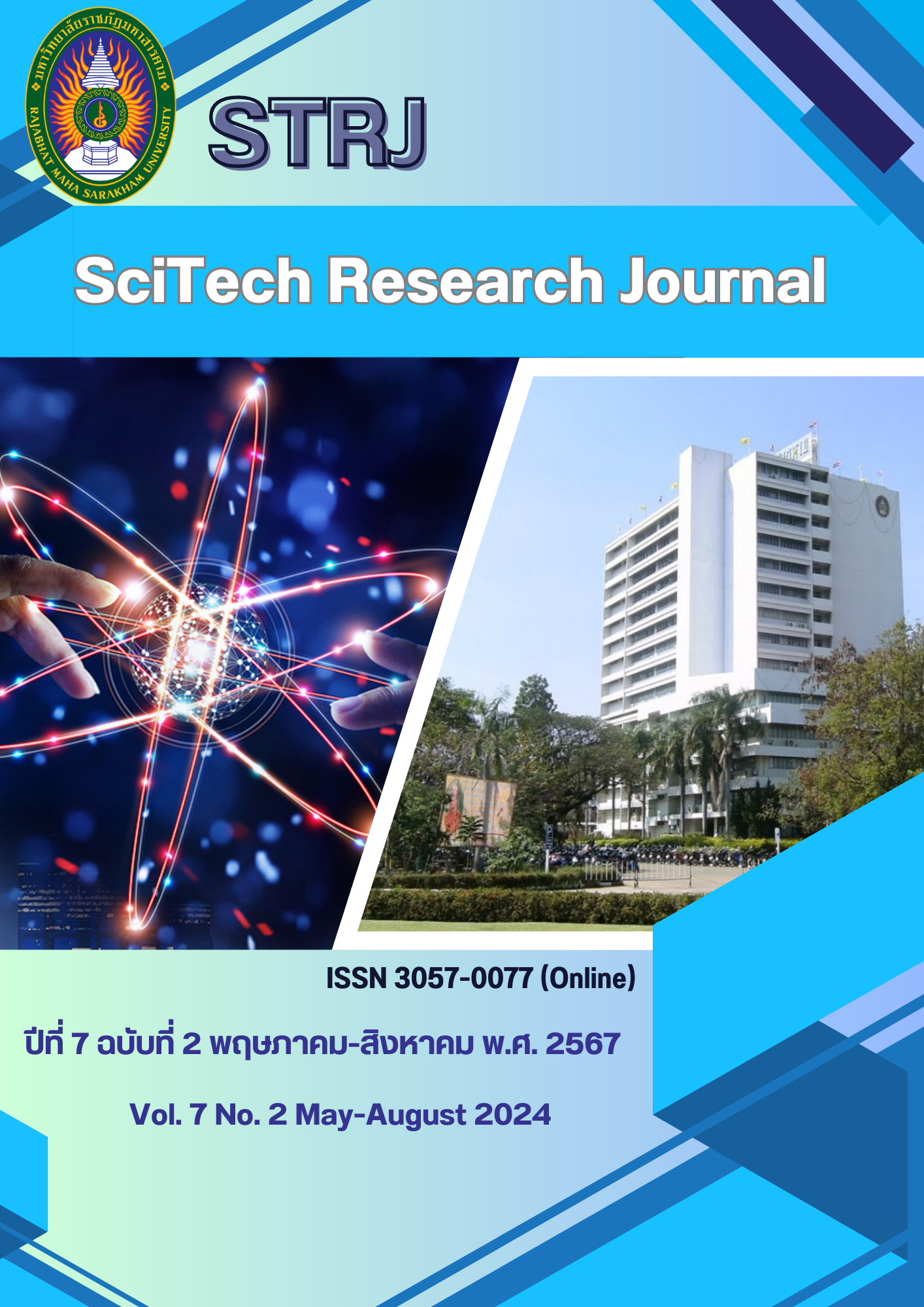The Production and Effect of Apple Coating from Cellulose of Corn Cob
Keywords:
Corn Cob, Edible Coating, CelluloseAbstract
This research aimed to produce the edible film from cellulose of 3 cultivars of corn cob, i.e., white sweet corn, yellow sweet corn, and purple sweet corn (KPSC 903), The experiment was study the most appropriate cultivars of corn cob to produce the edible film for coating apples with different ratios of 1:1 and 2:1. The results indicated that the purple sweet corn cob was the most appropriate with the highest sensory scores of 6.90. The study of the appropriate quantity of cellulose to protect apple with different percentage at 0, 5 and 10 respectively, were storage at 4°C and 30°C. It was found that the coated apples with 5 percent of cellulose got the highest overall liking score at 7.50. The shelf-life of coated apples with 3 ratios of cellulose were also studied during storage for 3 weeks. It showed that the coated apples with 5 percent of cellulose at 4°C could maintain the nutrition of apple by measuring the Total Soluble Solid (TSS) it got the highest value at 17.97 °Brix; and either protected color which had the highest a* value of 22.25. Moreover, it reduced dehydration during storage with the highest firmness value of 7.47 Kg (peeled apple) at 4°C, and 7.33 Kg (unpeeled apple) at 30°C. which was caused the coated apple got lowest weight loss at 0.17 g and obtained the highest sensory score at 8.
References
AOAC. (2000). Official Methods of Analysis. Gaithersburg, MD, USA: AOAC International.
BAM. (2001). Food and Drug Administration Bacteriological Analytical Manual. USA: AOAC International.
B. M. Watts, G. L. Ylimaki, L. E. Jeffery & L. G. Elias. (1990). Basic Sensory Methods for Food Evaluation. Journal of Biological Wastes, 33(3), 228.
Chansuk, T. et al. (2019). Carboxymethyl Cellulose from Corn Peel. 16th International Conference, Kasetsart Kamphaengsaen: University.
Chudhangkura, A. (2018). Colour corn: Purple corn. Journal of Food, 48(2), 25-32.
Chunhasawatdikun, B. & Sakkathamnu, P. (1996). Value of dietary fiber prevents and treats many diseases. Bangkok: Ruamtus.
Davis et al. (2003). User acceptance of Information Technology: Toward a Unified View. Journal of MIS Quarterly, 27(3), 425-478.
Department of Medical Sciences. (2017). Criteria for Microbiological quality of food and contact containers food. Nonthaburi: Ministry of Public Health.
Dhall, R.K. (2013). Advances in Edible Coatings for Fresh Fruits and Vegetables: A Review. London: Taylor & Francis.
Hagenmaier, R.D. (2000). Evaluation of a polyethylene – candelilla coating for “Valencia” oranges. Journal of Postharvest Biology Technology, 19(2), 147-154.
Jit-uea, K. (2021). Sweet corn seed production technology. Bangkok: Department of Agriculture.
Klinsoda, J. (2016). Edible coating and film for vegetables and fruits. Journal of Food, 46(1), 27-31.
Kocira, A., K.Kozłowicz, K.Panasiewicz , M. Staniak, E.S. Krok & P.Hortynska. (2021). Polysaccharides as Edible Films and Coatings: Characteristics and Influence on Fruit and Vegetable Quality—A Review. Journal of Agronomy, 813(11), 1-38.
Lertmanorat, J. & et al. (1996). Utilization of cellulose extraction from bagasse in chocolate cake low calories. Master’s dissertation: Chulalongkorn University.
Muchlisyam, U., Harahap, J., Silalahi & Z. Alfian. (2013). Isolation and Utilization of corn cobs hemicellulose as chelating agent for lead ions. The Malaysian Journal of Analytical Sciences, 17(1), 71-74.
National Bureau of Agricultural Commodity and Food Standards. (2019). Standard of Apple. Bangkok: Thai agricultural standard.
Noijinda, S. (2006). Techniques for measuring the firmness of fresh fruits and vegetables. Bangkok: King Mongkut’s University of Technology North Bangkok.
Pongnoree, J. & Kongbangkerd, T. (2006). Preparation of cellulose from corncobs I: Study on cellulose extraction. Science Technology Journal of Songklanakarin, 28(1), 191-199.
Pornjalean, R. & Jaidee, A. (2021). Development of Carboxymethyl Cellulose Coating Combined with Galanga Extract on Postharvest Guava Presevation. National Academic Conference. Kamphaengphet: Kamphaengphet Rajabhat University.
Phungam, N. & et al. (2021). Effects of Coating using Carboxymethyl Cellulose from Corn Leaves on Qualities of Fresh Pepper during Storage. Journal of Agricultural Science, 52(1), 401-404.
Ratanakamnuan, U. (2015). Effect of Plastic on Physical and Mechanical Properties of Cellulose Ester Films from Rice Straw and Corn Husk. Maejo: Maejo University.
Ratnapanon, N. (1994). The Foundation of Nutrition. Bangkok: Odean Store Printing.
Rongsuphan, T. & Kajorncheappunngam, S. (2018). Anthocyanin content, antibacterial activity and antioxidant capacity of purple corn cob extract via ultrasonic extraction. Science and Technology Research Journal of Phranakhon Rajabhat University, 14(1), 47-61.
Seenam, P. & Sangnark, A. (2012). Production and Fortification of Cellulose Powder Prepared form Corn Cobs for Decreasing Oil Uptake of Chinese Dough Product (Patongco). Bangkok: Kasetsart University.
Thongyong, S. & Dejkamhaeng, P. (1987). The foundation of food chemistry. Bangkok: Odean Store Printing.



